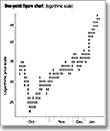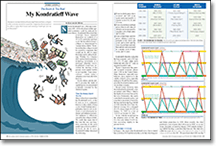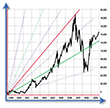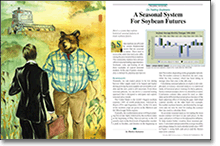Letters To The Editor
March 2010 Letters To The Editor
The editors of S&C invite readers to submit their opinions and information on subjects relating to technical analysis and this magazine. This column is our means of communication with our readers. Is there something you would like to know more (or less) about? Tell us about it. Without a source of new ideas and subjects coming from our readers, this magazine would not exist.
Address your correspondence to: Editor, Stocks & Commodities, 4757 California Ave. SW, Seattle, WA 98116-4499, or E-mail to editor@traders.com. All letters become the property of Technical Analysis, Inc. Letter-writers must include their full name and address for verification. Letters may be edited for length or clarity. The opinions expressed in this column do not necessarily represent those of the magazine. —Editor
VALUABLE INFORMATION
Editor,
I just wanted to send you a note regarding S&C. I have been a subscriber for a while but haven’t done a lot of reading of your magazine. However, while spending the holidays at my son’s house, I completely went through the December 2009 issue. I discovered that virtually every page has valuable information, and it was a very educational experience.
I will be reading further issues of S&C from cover to cover.
—John J. Dueweke
Thank you for writing. Our goal is always to provide ideas and information in every issue to help readers trade better, and we appreciate feedback from our readers.
—Editor
POINT & FIGURE CHARTING SOFTWARE
 Editor,
Editor,
I have a question regarding point & figure charting. I mostly use MetaStock and AmiBroker for technical analysis. They are both excellent in what they do, but I am looking for charting software that is dedicated to point & figure.
What is some of the charting software that S&C has reviewed? What about Bull’s-Eye Broker (www.pointandfigure.com/)?
—Rajiv Vyas
Baltimore, MD
We reviewed Bull’s-Eye Broker in our July 2001 issue, available from our Online Store at www.traders.com. Reviews of other software that we have published are also available there. (The search engine can help you locate specific reviews.)
Several programs are available that include the capability to chart point & figure. As for software that is dedicated to P&F charting, try doing an Internet search for point & figure software and you’ll find several that are available.
—Editor
KONDRATIEFF WAVE THEORY
 Editor,
Editor,
I read with fascination Koos van der Merwe’s article in the November 2008 issue of Stocks & Commodities regarding the Kondratieff wave theory as it applies to current market conditions as well as to the future.
Apparently, van der Merwe got sidetracked trying to predict the nadir of the market meltdown in 2008�09. As we now know, the bottom of the S&P was 666. To me that is irrelevant, since that’s now water under the bridge. What I am concerned about is the future, as I am back in the market since this past summer.
From my understanding of the graphs in his article, we should be in a downward slide in valuations into 2012; and yet I see the market “melting” up. So is it appropriate to buy into this market well into 2016, the year I plan to retire and then cash out? And if so, in what can I stabilize my assets, given that “things” will be losing value and cash will be worthless?
—Name withheld
Koos van der Merwe replies:
The K-wave is still on track for a correct prediction, and as an interpretation you should consider the following.
a. The year 2012 starts in January and ends in December. Allowing for error it could therefore be December 2011 or January 2013. I have found that the error margin can be as much as a year; for example, the K-wave called for the major market correction (Elliott wave Abc) in 1999. The start of the Abc correction, as you know, only started in the year 2000 (March).
b. Elliott wave theory has shown that the Abc correction is over. The market should now start rising in a five-wave upward move. At the moment, as I write this, the market is in wave I of the uptrend. Unfortunately, wave I is followed by a wave II correction, which can be simple (abc) or complicated (abcxabc), and can be as much as 72% of the rise of wave I. My charts are suggesting that the correction should start sometime between March 2010 and July 2010. This, in layman’s terms, should justify those bears calling for a double-dip recession. By the way, personally, I believe that wave II will be flat — by that I mean not much of a correction — but I could be wrong. Time will tell.
c. The wave II bottom, and the start of wave III, the true bull market, should only start in 2012, allowing for error, as discussed here.
I hope I have answered your question satisfactorily. If not, please do get back to me.
WD GANN ARTICLES
 Editor,
Editor,
In the January 2010 Letters To S&C column, a letter was published from one of your readers requesting more articles on W.D. Gann’s approach to the market.
I have prepared several articles on Gann theory, Gann charting, and Gann ratios and proportions. I have written on what I found to be successful in my trading when I traded successfully using only Gann techniques.
—Jacob Singer, PhC
Readers can look for these articles on Gann theory and technique in upcoming issues of Stocks & Commodities.
—Editor
ERRATA: JANUARY 2010 TRADERS’ TIPS
Editor,
The authors of “The Vortex Indicator” (Stocks & Commodities, January 2010) informed us of a minor error in our eSignal formula code provided for the January 2010 Traders’ Tips section. Accordingly, we have changed the formula parameters to a single-length parameter instead of two.
—Jason Keck
eSignal.com
Readers will find the updated eSignal code at our website, www.traders.com, in the January 2010 Traders’ Tips section.
—Editor
ERRATA: NOVEMBER 2009 TRADERS’ TIPS
 Editor,
Editor,
After he read my November 2009 Traders’ Tips contribution for use in Wealth-Lab, Markos Katsanos, author of the November 2009 S&C article “A Seasonal System For Soybean Futures,” on which the Traders’ Tip was based, contacted me about the details of the chandelier stop exit.
When he added it to his strategy, he found its effect to be very negative, not positive. After several email followups, I revised the WealthScript code, which had both logical and interpretation errors based on the article and my unfamiliarity with EasyLanguage code, which was used in Katsanos’ article.
The WealthScript code revision more accurately represents the strategy that Katsanos presented in his November 2009 article. The results really are outstanding. My apologies to Mr. Katsanos and S&C readers for not getting it right the first time.
—Robert Sucher
Wealth-Lab.com
Readers will find the revised Wealth-Lab code at the Traders.com website in the November 2009 Traders’ Tips section under “Wealth-Lab” as well as at Wealth-Lab’s website at https://www2.wealth-lab.com/WL5WIKI/Default.aspx?Page=TASCNov2009a&AspxAutoDetectCookieSupport=1, in the Wealth-LabWiki area.
—Editor